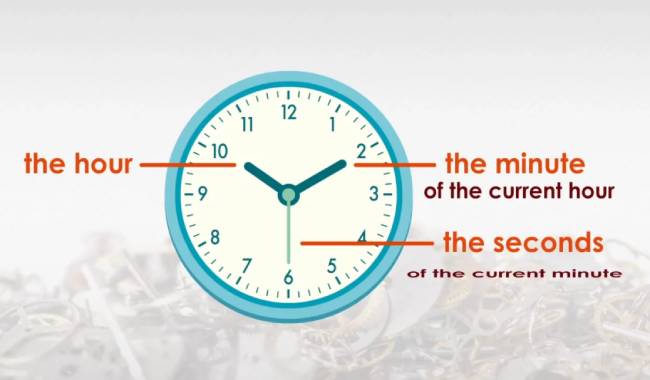How To Read A Clock? Several Ways
How to read a clock? Reading a clock with hands can be challenging, especially for those who are unfamiliar with the traditional analog clock. However, understanding how to read this type of clock is an essential skill that everyone should have. This article will provide step-by-step instructions for learning how to read a clock with your hands.
The first step in reading a clock with hands is to identify the two primary components: the hour hand and the minute hand. The hour hand points towards the number of hours that have passed since midnight while the minute hand indicates how many minutes have elapsed in an hour. Make sure you understand which is which before proceeding further.
After recognizing each of these components, take note of where they are pointing on the face of the clock and compare them to their labeled positions on the dial.

How To Read A Clock In English
Do you need to learn how to read a clock in English? It’s actually quite easy once you understand the basics. By following these simple steps, you’ll soon be able to read any clock in English without thinking twice.
First, observe the hour hand of the clock and identify which number it is pointing at on the face of the clock. This will indicate what hour it is currently. For example, if the hour hand is pointing at 11, then that means it is 11 o’clock in the morning or evening depending on whether it’s a 12-hour or 24-hour clock.
Next, look for the minute hand and determine which number it’s pointing to on the face of the clock. This will tell you how many minutes have passed since that particular hour began – e.g.
How To Read A Clock For Kids
Knowing how to read a clock is an important skill for children of all ages. Reading a clock requires an understanding of the 12-hour system and being able to differentiate between the hour and minute hands. Luckily, teaching kids to read a clock isn’t as hard as it may sound! Here are some tips on how to read a clock for kids:
First, teach your child the basics by breaking down what each number means on a standard 12-hour analog or digital clock. Explain that time is divided into hours, minutes, and seconds and show them which hand measures each unit of time (the long hand indicates hours while the short one shows minutes).
Then explain that there are 60 minutes in an hour and 60 seconds in each minute. Once they understand this concept, you can move on to more advanced topics such as telling time from quarter pasts or half-hours.
How To Read A Clock Game
Knowing how to read a clock is an essential skill for all ages. It can help with time management and scheduling tasks efficiently, which is why it’s important to teach children the basics of telling time. The game How To Read A Clock Game offers an interactive and fun way to learn the concept of telling time.
This online game encourages players to practice their skills by recognizing times displayed on analog clocks. Players are presented with various levels ranging from beginner to expert, depending on their prior knowledge of reading clocks.
As they advance through the levels, they must correctly identify various times displayed in digital and analog formats in order to win points and rewards. In addition, they can also compete against friends in multiplayer mode or challenge themselves by competing against other players from around the world via leaderboards.
How To Read Minutes On A Clock
For many, reading a clock is a skill that is taken for granted. However, understanding how to read the minutes on a clock can be difficult for some. Whether you are looking for the time or trying to set an alarm, it is important to know how to interpret the minute hand of an analog clock. Here’s how you can do so accurately and quickly:
The first step in learning how to read minutes on a clock is identifying the position of the hour hand. The hour hand should be considered as ‘12’ when pointing directly up or down at either side of the face.
You can then count up from 12 until you reach where the minute hand currently sits. The number you land on will tell you what hour it currently is; if it’s between two numbers, use your judgment and round up or down accordingly.
How To Read An Analog Clock
Knowing how to read an analog clock is a valuable skill that everyone should learn. It may seem intimidating at first glance, but it does not have to be! With a few simple steps, anyone can learn how to quickly and easily read the hands on an analog clock.
In order to read an analog clock, you must first be able to identify the hour hand and the minute hand. The hour hand will be longer than the minute hand and is typically colored in a different hue than the minute hand.
Both hands will move around a circular dial made up of numbers that represent hours. Start by locating “twelve o’clock” which is located directly above the number twelve on the dial.
How To Read A Watch Without Numbers
Watches without numbers can be a challenge to read. However, they are still possible to interpret if one knows what to look for. Understanding how a watch without numbers works will help you keep track of time more easily.
There are two parts of a watch that needs to be considered when trying to read it without numbers: the hands and the markers on the face. The hands indicate hours, minutes, and seconds depending on their position around the face of the watch.
Meanwhile, there are usually 12 markers that represent each hour in an analog clock, with 3-hour blocks divided into four smaller marks each representing 15 minutes apart from the other, and five-minute intervals between them indicated by small dots or lines extending from the center circle of the watch. In addition, some watches have additional markers that indicate half-hour intervals as well as ones for quarter-hour increments.
How To Read Seconds On A Clock
Reading seconds on a clock can be tricky for beginners, but with some practice and dedication, it can become second nature. Understanding the concept of reading seconds is simple: each second is divided into sixty parts, ranging from 0 to 59.
To read a clock in seconds accurately, you must first know the hour and minute hands’ position on the clock face. Once you have established where these hands are pointing, simply use them as reference points to calculate the number of seconds that have elapsed since 12 o’clock.
Reading the exact time in seconds requires careful observation; take note of how many times each hand has passed its marker since 12 o’clock. For example, if it’s 10 minutes past 2 o’clock, you’ll need to add 10 minutes (600 seconds) to 2 o’clock (1200).
How To Tell Time On A Digital Clock
Telling time on a digital clock is an important skill to have and one that is used daily. Despite the popularity of smartphones and other devices, traditional digital clocks remain commonplace in many homes, businesses, and schools. This guide will help you learn how to tell time on a digital clock quickly and accurately.
To begin reading the time on a digital clock, start by locating the hour digits at the top of the display. The first number represents the current hour in either a 12-hour or 24-hour format depending on your settings.
After this, focus on the minutes below which are usually separated from hours by two dots called colons. The numbers indicated here represent minutes past the hour.


